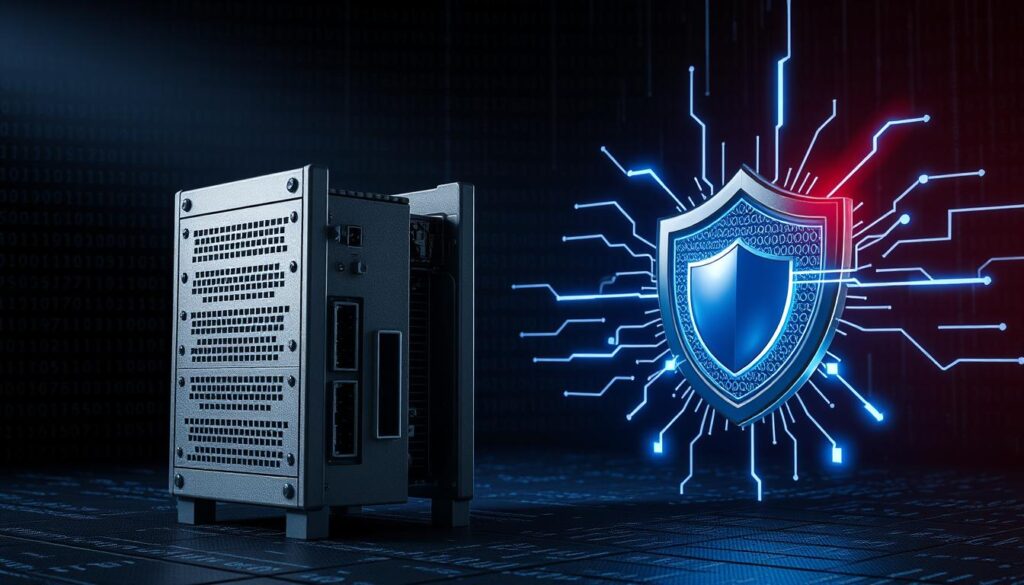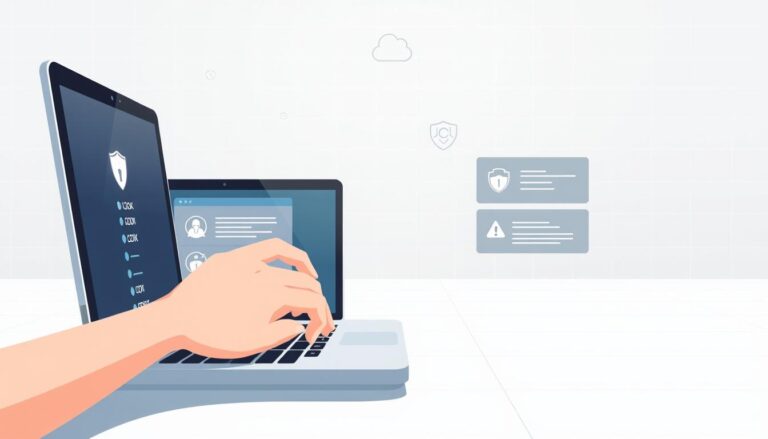Firewall vs Antivirus: What’s the Difference?
Understanding how network controls and endpoint scanners work helps you choose the right protection today. This introduction explains the core roles and practical gaps between a perimeter device that inspects traffic and software that scans files on devices.
Firewalls monitor packets and enforce rules to allow or block connections. Next‑generation firewalls add intrusion prevention, sandboxing, data loss prevention, web and email security, and can handle VPNs and NAT.
Antivirus software scans files and programs using signature and behavioral methods. It quarantines or deletes malware and can automate remediation to restore endpoints to a clean state.
Both controls can overlap: NGFWs may include anti‑virus scanning at the network edge, and endpoints often run host firewalls for device‑level control. Together, they form layered protection that lowers risk without unduly harming performance or usability.
Key Takeaways
- Perimeter devices focus on traffic control; endpoint tools scan files and processes.
- NGFWs extend capabilities beyond simple packet filtering.
- Antivirus uses signatures and behavior to detect and remediate malware.
- Combined controls provide better defense in depth for network security.
- Match protections to systems and threats to balance security and performance.
Why “Firewall vs Antivirus” matters in today’s network security
When companies face diverse attacks, knowing how network edge controls and device software differ shapes security plans.
Perimeter tools define network boundaries, segment private systems from the public Internet, and enforce access for incoming and outgoing traffic. Next‑generation options add IPS, sandboxing, DLP, and web and email security to stop many attacks before they reach devices.
Endpoint protection detects malware on systems using signature databases and behavior analysis. It can quarantine or delete threats and run automated remediation to restore infected devices.
Because threats today combine phishing, web exploits, and lateral movement, relying on one control is risky. Defense‑in‑depth pairs edge inspection with on‑device scanning so companies protect data and users across the network and on each system.
- Inspect traffic at the boundary to control access and block mass attacks.
- Run antivirus on endpoints to remove infections that slip past perimeter checks.
- Use NGFW features alongside endpoint software to cover more attack types.
What is a firewall? Core concepts and types used in modern networks
Network edge controls act as gatekeepers, examining traffic to stop unwanted access and contain risks.
A firewall is a security control that inspects network traffic and enforces rules to allow or block connections. At the most basic level, all firewalls implement packet filtering, checking headers like source and destination addresses and ports to apply policy.
Stateful engines add context by tracking connection state so legitimate packets in an established session are treated correctly.
Deep packet inspection (DPI) goes further and reads content to find protocol misuse or hidden threats that simple filtering might miss.
Levels and types
Firewalls work at different levels: application‑level proxies handle specific apps, network‑layer devices perform packet filtering and stateful inspection, and circuit‑level proxies manage sessions and address hiding.
Next‑generation features
NGFWs combine IPS, sandboxing, web and email security, DLP, and access control so one platform can stop brute‑force attempts, DoS, and exploitation.
Where they sit
In modern networks, firewalls live at the Internet edge, inside internal segments to isolate sensitive systems, and as remote access VPN gateways. By enforcing rules on incoming outgoing traffic, they reduce exposure to threats and help protect data and compliance needs.
“A properly placed firewall limits what reaches critical systems and centralizes policy enforcement.”
- Packet filtering: header checks and basic blocking.
- Stateful inspection: connection context for smarter decisions.
- DPI and application controls: content-aware protection.
How a firewall works: traffic inspection and policy enforcement
Network gateways examine packet headers and enforce access policies to stop unwanted connections.
Rules, access control, and filtering of incoming and outgoing traffic
A firewall inspects packet headers and applies rule sets that allow or deny connections based on IPs, ports, and protocols. It uses access control lists to permit trusted services and block risky ones.
Stateful inspection groups packets into flows so the device can tell a legitimate response from unsolicited probes. That filtering helps spot scans, brute‑force attempts, and unusual packet sequences that suggest attacks.
Network routing, NAT, and segmentation benefits for companies
Modern appliances also handle routing, NAT, and VPN endpoints so the same system can steer traffic and hide internal addressing from the public Internet.
Segmentation limits the blast radius of incidents by isolating critical data and services. Policy objects let companies standardize which applications, users, and services are allowed across the network.
- Rule‑based logic enforces consistent access and reduces threats.
- Inline prevention features block exploitation before a system is hit.
- Monitoring incoming and outgoing traffic detects command‑and‑control callbacks and data exfiltration.
“Consolidating prevention, access, and networking features reduces operational complexity and strengthens security posture.”
What is antivirus software? Purpose, scope, and coverage
Endpoint protection scans and vets files on each device so threats can be stopped before they run.
Antivirus software focuses on endpoint defense by scanning files and programs on a system to find and stop malware. It compares file contents to known signatures and uses behavior checks to catch unfamiliar threats.
From signature-based detection to behavior blocking
Signature detection matches a file against a database of known identifiers. Updates push new signatures so programs can spot the latest threats.
Heuristics and runtime monitoring watch for suspicious code patterns or actions. These methods let software flag malware even without a direct signature.
Four generations of endpoint protection
Early scanners used exact signature matches. Later heuristic engines added integrity checks and pattern rules.
Activity traps watched runtime behavior in memory. Modern suites combine prevention, behavior blocking, web filtering, and spam protection to reduce exposure.
“Prevention at the device level remains the last line before an infection can take hold.”
- Scans and real-time monitoring protect files and running programs.
- Balancing detection depth with system resources keeps performance acceptable.
How antivirus works: detection, quarantine, and automated remediation
Detection on the endpoint blends frequent signature updates with live behavioral monitoring to reduce exposure.
Antivirus engines run scheduled and real‑time checks across files and programs. On‑access scanning inspects files at open, write, and execution. On‑demand scans sweep the system or selected folders for deeper coverage.
Signature databases provide fast matches for known threats. Vendors push updates regularly because gaps leave systems open to recent variants of malware and viruses.
Quarantine versus deletion: handling suspicious items
When a match or odd behavior is found, many solutions quarantine the file. Quarantine isolates the item so it cannot run while preserving it for analysis and false‑positive review.
Deletion removes the file immediately. That eliminates risk but also discards evidence. Policies commonly favor quarantine first unless the file is clearly malicious.
Automated remediation and returning systems to normal
Advanced software can automate remediation tasks: remove dropped components, clean registry entries, and undo persistence mechanisms. This restores the system without a full restore or device wipe.
- Scans and runtime checks detect suspicious files and program behavior quickly.
- Frequent signature updates close detection gaps for new threats.
- Quarantine preserves evidence; deletion removes risk when necessary.
- Automated remediation cleans the system and documents actions for compliance.
“Quarantine buys time for analysis while remediation returns the device to a known‑good state.”
Firewall vs Antivirus: key differences and similarities
At their core, these tools inspect different layers: one watches network flows while the other scans files on each device.
Deployment layer: network boundary protection vs endpoint security
Network appliances sit at edges and between segments to enforce access and filter incoming outgoing traffic.
Endpoint software runs on systems to protect local resources and take action when malware is found.
Data inspected: packets and traffic vs files and processes
Edge devices analyze packets, packet headers, and traffic flows to detect suspicious patterns and apply filtering rules.
Endpoint tools focus on files, running processes, and behavior to perform detection and remediation for viruses or other threats.

Overlap and complementarity: host controls and defense‑in‑depth
Some NGFWs perform anti‑virus checks on web and email streams, while many endpoints run a host firewall to enforce access locally.
Together, these solutions reduce exposure: perimeter inspection stops many attacks before they reach systems, and endpoint detection cleans up what slips through.
- Different visibility—network versus device—makes them complementary.
- Centralized policies with device‑level remediation speed up response.
- Deploy both to create layered protection that improves overall outcomes.
Advantages and limitations: where each solution excels—and where it doesn’t
Each control shines in different scenarios, so knowing their limits helps you plan better defenses.
Strengths and limits for edge controls
Firewalls deter unauthorized access, enforce segmentation, and apply filtering rules to stop many attacks at the perimeter and between zones.
They inspect packets and apply rules to block suspicious connections. But encrypted payloads, insider actions, and local media introduce blind spots they cannot cover.
Strengths and limits for endpoint scanners
Antivirus excels at finding and removing malware on a system. It blocks viruses, Trojans, and spyware and can flag risky websites or spam.
Effectiveness relies on timely updates. Read‑only files or files opened simultaneously may evade scanning, and real‑time checks can consume resources and affect performance.
“Combine boundary controls with device-level scanning to close gaps and speed recovery.”
- Use segmentation, IPS, and sandboxing at the boundary with endpoint programs on devices.
- Review rules and enforce updates to lower false positives and missed detections.
- Apply egress filtering and removable media controls to cut data exfiltration and reinfection risks.
Choosing the right protection level for your systems and users
Deciding the right protection means matching controls to how people use devices and the risks those systems face. Start by mapping who needs access, where they connect, and what data must stay safe.
Personal devices benefit from strong endpoint tools. Use behavior monitoring, modern antivirus programs, and DNS/web filtering. Add a host firewall to block unsolicited access and keep casual risk low.
Business networks need layered controls. Deploy NGFW features at boundaries—IPS, DLP, sandboxing, email and web security, VPN termination, routing, and NAT. Enforce endpoint software across managed devices for consistent prevention.

Feature checklist: IPS, DLP, sandboxing, CDR, behavior monitoring
- IPS for exploit attempts and inline blocking.
- DLP to stop sensitive data leaving the network.
- Sandboxing plus CDR to handle zero‑day files and deliver safe content quickly.
- Behavior monitoring on endpoints to detect unknown malware and enable fast analysis.
- Integration of policy and telemetry to speed incident response across solutions.
“Balance prevention with usability: tune signatures, allowlists, and exceptions to reduce disruptions.”
Working together: a layered security strategy for the present
Layering network defenses with endpoint tools gives teams faster ways to stop and clean threats.
Integrating NGFWs with endpoint antivirus programs
NGFWs can include anti‑virus scanning and inline IPS so many attacks are blocked at the boundary. That reduces load on devices and lowers the chance that malware reaches user systems.
When suspicious files pass the edge, sandboxing detonates them safely for behavioral analysis. Content Disarm & Reconstruction (CDR) removes active elements and returns a safe file in seconds while the original undergoes deeper analysis.
Zero‑day defense with sandboxing and content disarm & reconstruction
Sandboxing observes unknown samples in isolation. CDR strips risky objects and gives users usable files almost immediately.
Coordinated prevention shortens dwell time: network controls stop known malicious traffic, and endpoint tools remediate what lands. Shared telemetry links network indicators to on‑device findings for faster analysis and response.
“Clear playbooks ensure consistent actions: quarantine, block, or update policy as telemetry dictates.”
- Connect boundary controls with endpoint programs so detections inform each layer.
- Use sandboxing and CDR to keep productivity while analyzing suspicious files.
- Share telemetry to refine rules and speed incident handling across the network and devices.
| Control | Primary role | Key benefit |
|---|---|---|
| NGFW (with AV + IPS) | Block and inspect traffic at the edge | Stops many threats before delivery; reduces endpoint load |
| Sandbox / CDR | Analyze unknown files; return safe file copies | Zero‑day analysis and safe files in seconds for users |
| Endpoint antivirus software | Detect and remediate on devices | Quarantine, clean, and restore infected systems |
| Shared telemetry & playbooks | Coordinate detections and responses | Faster incident resolution and refined prevention |
Conclusion
, Clear roles make choosing protections easier. The article on firewall vs. antivirus highlights essential differences so teams pick the right mix for their needs.
Perimeter devices and host scanners address separate layers of risk. A firewall and complementary tools give segmentation, access control, and inline prevention at the network edge.
Endpoint software inspects files and processes with signatures and behavior checks. Modern antivirus handles quarantine and automated remediation so infected systems recover fast.
The best outcome uses both layers, shared telemetry, and regular policy reviews. This defense‑in‑depth approach keeps data safe, reduces dwell time, and helps companies adapt to new threats and maintain strong cybersecurity today.
FAQ
What is the main difference between a network traffic filter and endpoint malware software?
The traffic filter focuses on controlling and inspecting data packets moving across network boundaries and internal segments, enforcing access rules and preventing unauthorized connections. Endpoint malware software protects individual devices by scanning files, monitoring process behavior, quarantining threats, and removing malicious code. Together they form layered defenses.
Why does comparing these two security types matter for businesses today?
Modern attackers use multi-stage campaigns that combine network exploits and file-based payloads. Understanding how each control works helps security teams design policies, choose devices and programs, and reduce gaps. Properly combined solutions improve threat prevention, detection, and incident response across servers, workstations, and cloud resources.
What are the core inspection techniques used by network filters?
Key techniques include simple packet filtering, stateful inspection that tracks connection state, and deep packet inspection (DPI) which examines payloads for protocols and signatures. Advanced systems add intrusion prevention, application awareness, and content scanning to block complex attacks.
What types of network devices handle traffic control and segmentation?
Devices include perimeter appliances, internal segmentation gateways, host-based firewalls on servers and desktops, and VPN concentrators for remote access. Next-generation appliances often combine routing, NAT, intrusion prevention, and web/email security in one platform.
How do rules and policies determine what traffic is allowed or blocked?
Administrators define rules based on IP addresses, ports, protocols, application signatures, and user identity. Policies can allow, deny, or inspect traffic, and often include logging, rate limiting, and alerts. Proper rule order and least‑privilege principles are essential to avoid misconfigurations.
How does endpoint protection detect and stop malware?
Endpoint protection uses signature databases, heuristics, and behavior monitoring to identify malicious files and processes. When a threat is found, the software can quarantine the item, block execution, roll back changes, and report the incident to management consoles for remediation.
What is the role of signature updates and why are they important?
Signature updates provide known threat indicators, enabling signature-based scanners to recognize previously identified malware. Regular updates ensure new strains are detected quickly. Modern suites also use cloud lookups and behavior analytics to reduce reliance on signatures alone.
When should a file be quarantined instead of deleted?
Quarantine isolates suspicious files to prevent execution while preserving them for analysis and potential recovery. Use quarantine when evidence may be needed for forensics or when false positives could disrupt critical applications. Deletion is reserved for confirmed malicious artifacts when recovery isn’t required.
How do these technologies overlap and complement each other?
Overlap exists where host-based controls inspect traffic or when next‑generation appliances include malware scanning. They complement one another because network devices can stop inbound threats and lateral movement, while endpoint tools catch file-based, in-memory, and user-targeted attacks that slip past network defenses.
What are typical blind spots for each solution?
Network devices may miss encrypted payloads, endpoint‑to‑endpoint lateral traffic, or attacks that originate from inside trusted segments. Endpoint software can be bypassed by fileless attacks, sophisticated memory exploits, or when updates lag. Combining controls and visibility reduces these gaps.
How should organizations choose features for their environment?
Start by mapping assets and risk: volume of remote users, critical servers, and data sensitivity. Prioritize intrusion prevention (IPS), data loss prevention (DLP), sandboxing, behavior analytics, and centralized management. Match performance and scalability needs to budget and administrative resources.
Can next‑generation network appliances replace endpoint protection?
No. While NGFWs with sandboxing and antivirus modules improve perimeter defenses, they cannot fully replace endpoint protection. Endpoints detect process-level anomalies, handle offline devices, and perform local remediation. A defense‑in‑depth approach keeps both layers active.
What is the best way to defend against zero‑day exploits?
Combine proactive measures: application whitelisting, behavior monitoring, sandbox detonation, content disarm and reconstruction (CDR), timely patching, and network microsegmentation. Rapid detection and automated containment limit impact while threat intelligence and updates improve defenses.
How do remote and hybrid workforces affect protection strategies?
Remote users increase dependence on endpoint controls, VPNs, and cloud security stacks. Ensure devices have strong endpoint protection, use secure access solutions, enforce least‑privilege policies, and employ continuous monitoring to detect anomalous behavior across distributed locations.
What metrics should teams track to evaluate effectiveness?
Monitor incident counts, mean time to detect and respond (MTTD/MTTR), blocked versus successful attacks, false positive rates, update compliance, and system performance impact. These metrics guide tuning and investments to improve overall security posture.







